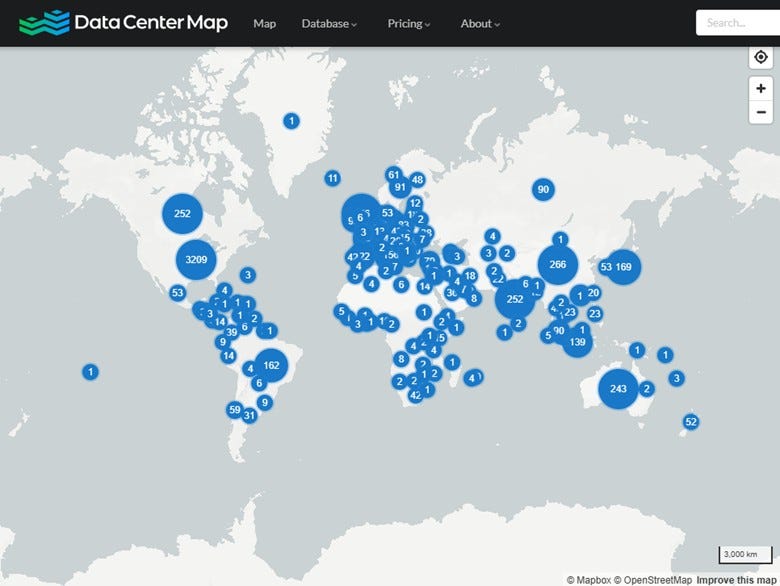Cryptocurrency, artificial intelligence (AI), and cloud computing are virtual products and technologies of the internet that are physically manifested in data centers. Cryptocurrency exists on a network of computers – mining data centers - requiring high computational power utilizing blockchain technology to validate and record transactions to cryptocurrency. AI uses computing resources to train, store, and deploy complex machine learning models and algorithms via a network of servers and computers. Cloud computing technology requires data centers where facilities, networks, and servers are shared between multiple customers and users. Cryptocurrency, AI and cloud computing are highly interrelated. For example, AI is integral to cloud computing to improve automation and scalability, while cloud computing provides the necessary infrastructure for AI. Cryptocurrency uses AI to improve the performance and stability of the crypto market.
Data centers are rapidly evolving and adapting to the dynamic needs of 21st century computing. Co-location facilities are one means of sharing space and resources between a variety of companies, municipalities, universities, and other virtual users. Cloud service providers (such as Amazon Web Services, Google Cloud, and Microsoft Azure) use hyperscale data centers – large-scale facilities that support massive data and cloud computing operations. These data centers are the tangible, spatial expression of location-based products of the virtual world.
Since 2007, the Data Center Map has tracked data centers around the world. Their interactive map identifies over 8,000 data centers in 162 countries. Each data center has a profile description and links to a satellite image of the site. The largest number of data centers are located in the U.S. and Europe followed by a growing number of centers in China, India, Australia and southeast Asia. According to the U.S. International Development Finance Corporation the demand for data centers in Africa will exceed 300 percent fueled by high-tech start-ups, cloud technology, and AI deployment.
DataCenter Interactive Map. Map source: https://www.datacentermap.com/datacenters/
The U.S. has the largest number of data centers with the densest data center hub in the world located in Virginia. The satellite image below shows a number of data centers – part of Data Center Alley - in northern Virginia surrounded by subdivisions and golf courses.
Data Center Alley, Virginia. Map data: Google, ©Airbus (image date: 11/4/2020)
Servers and computers are the backbone of data centers – the physical infrastructure – that require electricity for high computational power and water for heat management of air flow and thermal control. Data centers are increasingly spatially concentrated impacting local and regional power networks due to more electricity consumption. Location-based carbon emissions from data centers affect climate targets due to added dependence on the existing power grids using coal and natural gas despite shifts to renewable energy sources.
Data centers are significant consumers of natural resources. For example, water is needed for cooling systems to manage heat - the by-product of digital computation. The water used in these centers is treated with chemicals to prevent corrosion and bacterial growth, making recycling difficult. Data centers indirectly consume water via the power plants that supply electricity. Data centers are in areas that are already water-stressed and prone to drought conditions such as the U.S. southwest and across sub-Saharan Africa. For example, Phoenix has 58 data centers using large amounts of water further straining a fragile water supply system.
Data center, Phoenix, AZ. Map data: Google, ©Airbus (Image date: 9/24/23)
In January 2025, the Trump Administration announced efforts to build, scale, and speed the development of AI infrastructure and data centers in the U.S. Project Stargate, a joint venture with leading AI companies will build new data centers under an accelerated timeline facilitated by an executive order declaring a “national energy emergency” that waives environmental permitting reviews. This investment in AI data centers require increased power plant development using coal and natural gas since the clean energy approach of the Biden administration has been rolled back. Public Citizen’s Energy Program states that fast-tracking these projects will raise utility bills for consumers, impact air quality and increase greenhouse gas emissions.
We need to monitor efforts to fast-track these projects that will impact our local environment. We have the tools and approaches necessary to adopt clean energy strategies in our own backyards that include green energy to meet the challenge for data centers necessary for 21st century computing.
NOTES
https://www.abiresearch.com/blog/data-centers-by-region-size-company
https://dgtlinfra.com/data-center-water-usage
https://www.volico.com/biggest-challenges-of-the-data-center-industry/
https://www.cbre.com/insights/reports/global-data-center-trends-2023
https://www.dfc.gov/investment-story/tackling-critical-need-data-center-infrastructure-across-africa
https://www.iea.org/commentaries/what-the-data-centre-and-ai-boom-could-mean-for-the-energy-sector
https://thereader.mitpress.mit.edu/the-staggering-ecological-impacts-of-computation-and-the-cloud/
https://www.jdsupra.com/legalnews/trump-2-0-ai-and-data-centers-in-a-time-4758609/






